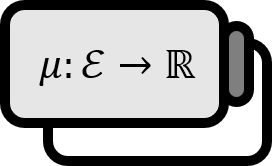Proof of the Dominated Convergence Theorem
Theorem 1
Given measurable sets $E \in \mathcal{M}$ and $g \in \mathcal{L}^{1} (E)$, let the sequence of measurable functions $\left\{ f_{n} \right\}$ satisfy $|f_{n}| \le g$ almost everywhere in $E$. If, almost everywhere in $E$, $\displaystyle f = \lim_{n \to \infty} f_{n}$ then $f \in \mathcal{L}^{1}(E)$. $$ \lim_{ n \to \infty} \int_{E} f_{n} (x) dm = \int_{E} f dm $$
- $f,g \in \mathcal{L}^{1} (E)$ means that $f$ and $g$ are Lebesgue integrable functions.
Explanation
Compared to the Monotone Convergence Theorem, the condition $f_{n} \nearrow f$ is missing, and there’s no need for $f_{n} \ge 0$ either.
Interestingly though, a $g$ that can “dominate” $\left\{ f_{n} \right\}$ is required, but eventually, $g$ does not appear in the result.
Proof
Part 1.
Let’s prove $f \in \mathcal{L}^{1}(E) $.
Since in $E$ we have $|f_{n}| \le g$, for all $x \in E$, $-g(x) \le f_{n} \le g(x)$ holds. Summarizing gives $$0 \le f_{n} (x) + g(x) \le 2 g(x)$$, and when $n \to \infty $, $$0 \le f (x) + g(x) \le 2 g(x)$$ thus $$(f+g) \in \mathcal{L}^{1}(E)$$ Meanwhile, $f = (f + g ) + ( -g)$ and since $\mathcal{L}^{1}(E)$ is a vector space, $f \in \mathcal{L}^{1}(E)$ holds.
Part 2.
Assume $f_{n} \ge 0$.
Fatou’s Lemma: For a sequence of non-negative measurable functions $\left\{ f_{n} \right\}$, $$\displaystyle \int_{E} f dm \le \liminf_{n \to \infty} \int_{E} f_{n} dm $$
By assumption and Fatou’s Lemma, $$\displaystyle \int_{E} f dm \le \liminf_{n \to \infty} \int_{E} f_{n} dm $$ and it suffices to show $\displaystyle \limsup_{n \to \infty} \int_{E} f_{n} dm \le \int_{E} f dm $.
Applying Fatou’s Lemma again to $g-f_{n}$ gives $$\displaystyle \int_{E} \lim_{n \to \infty} (g - f_{n}) dm \le \liminf_{n \to \infty} \int_{E} (g - f_{n} ) dm $$. Here, since $f, g \ge 0$, the left side is $$\displaystyle \int_{E} \lim_{n \to \infty} (g - f_{n}) dm =\int_{E} g dm - \int_{E} f dm$$ and the right side is $$ \begin{align*} & \liminf_{n \to \infty} \int_{E} (g - f_{n} ) dm \\ =& \liminf_{n \to \infty} \left( \int_{E} g dm - \int_{E} f_{n} dm \right) \\ =& \int_{E} g dm - \limsup_{n \to \infty} \int_{E} f_{n} dm \end{align*} $$. Summarizing, $$ \int_{E} g dm - \int_{E} f dm \le \int_{E} g dm - \limsup_{n \to \infty} \int_{E} f_{n} dm $$ Since $g \in \mathcal{L}^{1} (E)$, $\displaystyle \int_{E} g dm < \infty$ holds, allowing for cancellation on both sides, and rearranging signs yields: $$\limsup_{n \to \infty} \int_{E} f_{n} dm \le \int_{E} f dm$$
Part 3.
To generalize for cases where $f_{n} \ge 0$ is not true, define $h_{n} := f_{n} + g$. Since $h_{n} \ge 0$, we can repeat the process in Part 2.
■
Capinski. (1999). Measure, Integral and Probability: p92. ↩︎
